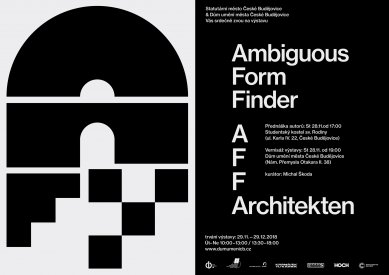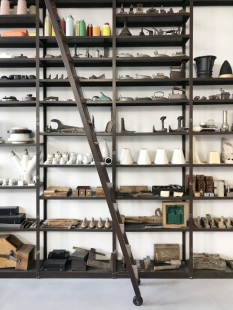
AFF architects: Ambiguous Form Finder
Source
DUČB
DUČB
Publisher
Tisková zpráva
28.11.2018 08:00
Tisková zpráva
28.11.2018 08:00
Czech Republic
České Budějovice
Martin Fröhlich
Sven Fröhlich
AFF Architekten
Lecture by the authors: on Wednesday, November 28 at 5:00 PM / Student Church of the Holy Family – Karel IV. 22, České Budějovice
Exhibition opening: on Wednesday, November 28 at 7:00 PM / Gallery of Contemporary Art and Architecture – House of Art, České Budějovice
Exhibition duration: November 29 – December 30, 2018
Curator: Michal Škoda
This year's final exhibition at the House of Art introduces a new project by the Berlin architectural studio AFF.
AFF perceives architecture as an object or as a sculptural work. This does not mean that their realized buildings should be understood as sculptures, that is, constructions where emphasis is placed primarily on the external appearance of the building. Their approach is based on a concept rooted in the very beginnings of individual projects, where they carefully develop and refine their works "on the go" using proven methods, so that the final result is an adequate and sensitive solution within the framework of the given assignment. That is, to be able to function from the perspective of the context of the place, as well as to fully function from the perspective of functional requirements.
Evidence of this is their diverse range of realizations and projects to date. Whether they are family houses, public buildings, or very successful reconstructions, such as the restoration of Freudenstein Castle in Freiberg, used for the Saxon Mining Archive.
The way the architects of AFF addressed the existing building, which included everything from clearing out to renovation, contributes to the current architectural debate on how to address the question of castles. The structure of the building embedded in another building, evoking the concept of an ark, symbolizes the protective function of the archival collections of one of the oldest mining regions in Germany. The rooms where the mineralogical collection is stored were structured by a system of built-in structures and constellation of display cases. The notion of physicality, as a shared characteristic of sculpture and architecture, from which AFF draws, is thus evident on various levels.
The architectural studio AFF was founded in 1999 by brothers Martin and Sven Fröhlich together with Torsten Lockl. They have a long list of realizations behind them, arising from both the sphere of private clients and from winning architectural competitions. Their work has also been recognized with numerous prestigious awards.
For the way of working that AFF prefers, their own memories and feelings are very important. At first glance, these may not seem significant, but they play an important role. The very process of creation is derived from objects and images from their own past and strong content, which can provoke with their mysteriousness in their "stories" and become a fundamental source of inspiration for the architects. A feature that can be traced in AFF's realizations is a certain diversity, where on one hand we can encounter a very radical austerity, both in opinion and materials, while on the other, there is the use of a rich palette of colors, materials, and ornamentation. Yet, it is always a confident, sensitive solution that elegantly enters the context of the given assignment.
For example, we can mention a cottage in the German part of the Ore Mountains, where the architects transformed a former ski hut into a remarkable "concrete" residence. In the same year (2010), they completed work on a primary school in Berlin—a building in the shape of an asymmetrical horseshoe, very sensitively placed in a garden among the trees. Surrounded by trees is also another realization, which is the Lindetal house in Mecklenburg, characterized by a striking element of black wooden planks on the facade, harmonizing with its surroundings. (2016)
The exhibition AFF Architekten at the House of Art Gallery in České Budějovice, with its name Ambiguous Form Finder, plays with the "brand" of the studio AFF, but primarily focuses on the craft in the context of top technological construction and design led by image. The condition is the necessity to re-discover craft in relation to its methods, tools, traditions, the world of images and local peculiarities, and to find an authentic approach with specific regard to the project.
Exhibition opening: on Wednesday, November 28 at 7:00 PM / Gallery of Contemporary Art and Architecture – House of Art, České Budějovice
Exhibition duration: November 29 – December 30, 2018
Curator: Michal Škoda
This year's final exhibition at the House of Art introduces a new project by the Berlin architectural studio AFF.
AFF perceives architecture as an object or as a sculptural work. This does not mean that their realized buildings should be understood as sculptures, that is, constructions where emphasis is placed primarily on the external appearance of the building. Their approach is based on a concept rooted in the very beginnings of individual projects, where they carefully develop and refine their works "on the go" using proven methods, so that the final result is an adequate and sensitive solution within the framework of the given assignment. That is, to be able to function from the perspective of the context of the place, as well as to fully function from the perspective of functional requirements.
Evidence of this is their diverse range of realizations and projects to date. Whether they are family houses, public buildings, or very successful reconstructions, such as the restoration of Freudenstein Castle in Freiberg, used for the Saxon Mining Archive.
The way the architects of AFF addressed the existing building, which included everything from clearing out to renovation, contributes to the current architectural debate on how to address the question of castles. The structure of the building embedded in another building, evoking the concept of an ark, symbolizes the protective function of the archival collections of one of the oldest mining regions in Germany. The rooms where the mineralogical collection is stored were structured by a system of built-in structures and constellation of display cases. The notion of physicality, as a shared characteristic of sculpture and architecture, from which AFF draws, is thus evident on various levels.
The architectural studio AFF was founded in 1999 by brothers Martin and Sven Fröhlich together with Torsten Lockl. They have a long list of realizations behind them, arising from both the sphere of private clients and from winning architectural competitions. Their work has also been recognized with numerous prestigious awards.
For the way of working that AFF prefers, their own memories and feelings are very important. At first glance, these may not seem significant, but they play an important role. The very process of creation is derived from objects and images from their own past and strong content, which can provoke with their mysteriousness in their "stories" and become a fundamental source of inspiration for the architects. A feature that can be traced in AFF's realizations is a certain diversity, where on one hand we can encounter a very radical austerity, both in opinion and materials, while on the other, there is the use of a rich palette of colors, materials, and ornamentation. Yet, it is always a confident, sensitive solution that elegantly enters the context of the given assignment.
For example, we can mention a cottage in the German part of the Ore Mountains, where the architects transformed a former ski hut into a remarkable "concrete" residence. In the same year (2010), they completed work on a primary school in Berlin—a building in the shape of an asymmetrical horseshoe, very sensitively placed in a garden among the trees. Surrounded by trees is also another realization, which is the Lindetal house in Mecklenburg, characterized by a striking element of black wooden planks on the facade, harmonizing with its surroundings. (2016)
The exhibition AFF Architekten at the House of Art Gallery in České Budějovice, with its name Ambiguous Form Finder, plays with the "brand" of the studio AFF, but primarily focuses on the craft in the context of top technological construction and design led by image. The condition is the necessity to re-discover craft in relation to its methods, tools, traditions, the world of images and local peculiarities, and to find an authentic approach with specific regard to the project.
The authors add: “In the era of technical reproducibility, not only the original sometimes gets lost, even copies lose their relationship to the original. There is a loss of knowledge of proven techniques and tools. We surround ourselves with them and use them as sources of ideas and references. On the path to our own identity, we report and copy. In construction, we always maintain a relationship to the place, but materials quickly lose their aura. If we focus exclusively on materials, we must discover in our developed society that they are utilized as sources through virtual images or the power of graphic association just like machinery for industrial production. We understand craft as a bridge to authenticity, which finds its strongest expression in the care of detail. Through a sequence of images of realized construction details, in collages of materials and tools, and in intermediates of the design process, we seek to clarify a method of design inspired by craft. Alongside personal insight, we expand the context of the exhibition with the views of photographer Hans-Christian Schink and architectural historian Anna Rosellini.”
The English translation is powered by AI tool. Switch to Czech to view the original text source.


0 comments
add comment






